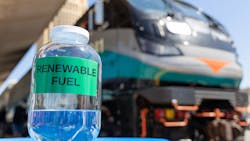Metrolink is first passenger rail agency in U.S. powered by renewable fuel
Metrolink has switched to renewable fuel, making it the first agency in the nation to completely power all its locomotives with the cleaner burning alternative.
“It’s a proud achievement to be the first rail agency in the nation to use renewable fuel to move people around southern California,” said Metrolink Board Chair Ara Najarian. “We are committed to continue working toward better air quality in our region and lessening our effect on climate change for the planet.”
To meet its aggressive climate targets, Metrolink launched a pilot program of renewable fuel in its locomotives in early 2021. The renewable product is made of recycled natural fats and vegetable oils. It contains no petroleum fossil fuels and thus burns cleaner, reducing harmful pollutants and decreasing greenhouse gas emissions of carbon dioxide by up to 80 percent.
“This transition by Metrolink to using renewable fuel will help further reduce the air pollutants from our locomotives and improve the air quality for all the communities along our 538 miles of track,” said Metrolink Board Vice Chair Larry McCallon, who is also a member of the South Coast Air Quality Management District's Governing Board. “It is certainly the right thing that we needed to do for the health of our children and our quality of life.”
Metrolink began powering 100 percent of all its locomotives with renewable fuel in February.
Metrolink shares this cleaner emissions milestone, as it continues to pursue zero-emissions technologies of hydrogen fuel cell and battery electric, is a bridge to zero emissions. By reducing locomotive emissions, Metrolink is easing environmental impacts on climate change and improving air quality for all.
“Metrolink is committed to protecting the environment, embracing social responsibility and creating economic vitality for our region,” Metrolink CEO Darren Kettle said. “Our board-approved Climate Action Plan paved the way to this moment, and it is the first step toward our zero-emissions future.”



